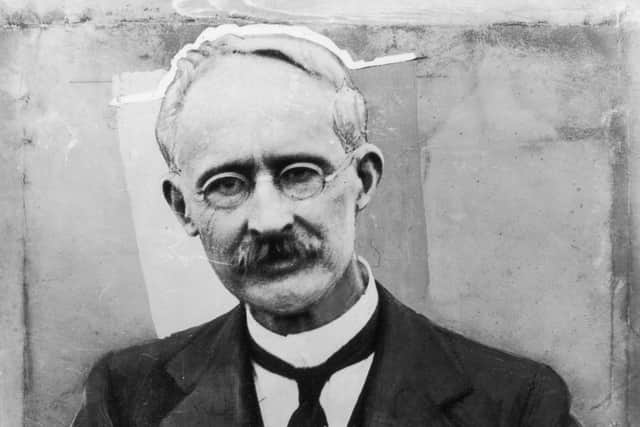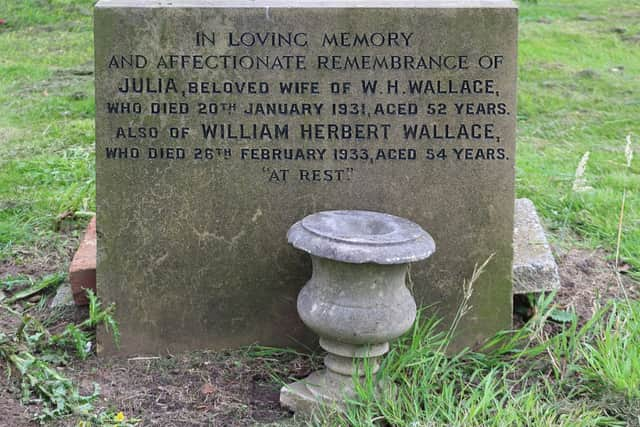Liverpool true crime: The mysterious unsolved ‘locked room’ murder of Julia Wallace and the Man from the Pru
and live on Freeview channel 276
Over ninety years ago, 60-year-old Julia Wallace was beaten to death at her home in Anfield and her husband was set to hang for her murder. However, this strange case isn’t quite as it seems.
It’s Liverpool’s oldest unsolved murder, and detectives have never been able to uncover what exactly happened to Mrs Wallace, in this ‘locked room’ mystery.
The Wallaces
Advertisement
Hide AdAdvertisement
Hide AdIn 1931, Julia and William Herbet Wallace had been married for sixteen years and lived together at 29 Wolverton Street, Anfield, Liverpool, with their cat ‘Puss’.
Mr Wallace, then 52, worked for the Prudential Assurance Company, and was well-liked by his colleagues. He was reported to regularly suffer from kidney problems.
The murder
The day before Mrs Wallace’s brutal murder, a telephone message was left for William at the Liverpool Central Chess Club, where he was a member, at around 7.15pm.
Club Captain, Samuel Beattie, spoke to the caller, who referred to himself as ‘R.M. Qualtrough’ and asked Wallace to visit his address ’25 Menlove Gardens East’ at 7.30pm, the following evening.
Advertisement
Hide AdAdvertisement
Hide AdMr Wallace was given the message when he arrived at the Chess Club around twenty minutes later, and believed the nature of the requested visit was to discuss insurance.
The following day, 20 January 1931, Mr Wallace is said to have left his Anfield home at around 6.45pm and boarded three trams to Allerton, in search of the address. Wallace said that Julia followed him down the yard bolting the gate behind him as usual after he left the home, however, there were no witnesses to confirm this and Wallace could not recall hearing the bolt. A tram conductor saw him on the tram at around 7.06pm.


At some time between 6.35pm and 6.40pm, the Wallace’s milk delivery boy, Allan Close, is said to have spoken to Julia, who he said handed her back empty milk bottles and told him to hurry home - this is crucial as Close is the only witness, other than Wallace, reported to have seen Julia alive around this time.
After speaking to passers by, visiting 25 Menlove Gardens West and searching the area for around 45 minutes, Mr Wallace discovered that ‘Menlove Gardens East’ did not exist, and headed home.
Advertisement
Hide AdAdvertisement
Hide AdNeighbours John and Florence Johnston saw Mr Wallace struggle to enter his home through the back or front doors at around 8.40pm, and when he finally managed to open the back door, he found his wife beaten to death in the living room. Mr Wallace noted that the gate was not bolted.
The Johnstons recalled Mr Wallace exclaiming, ‘Oh look! She’s been killed!’ and so they entered the property, finding Julia lying on a coat, surrounded by a pool of blood.
Mr Johnston called the police and they arrived shortly after. A locked kitchen cupboard where Mr Wallace kept money had been forced open and was now empty, but the majority of the house seemed untouched.
The investigation
After the murder, police traced the call from ‘R.M. Qualthrough’ to a phone box on the corner of Rochester Road and Breck Road, just 400 yards away from the Wallace’s house and right next to the stop where he caught the tram to the chess club.
Advertisement
Hide AdAdvertisement
Hide AdA forensics expert, John Edward Whitly MacFall, estimated the time of death to be around 8.00pm.
The police believed Julia’s husband to be the killer, despite the fact that he was seen on the 7.06pm tram, with no blood on his clothes, and was not home at the time of death. As Julia was seen by Allan Close at around 6.40pm, this means Mr Wallace would have had less than half an hour to kill Julia, change his clothes, clean himself of any blood, walk to the tram stop and be sighted on a tram at 7.06pm.
Conducting tram tests, police determined the time Wallace could have left home in order to get the tram at Smithdown Lane at 7.06pm.
After conducting six tests, detectives said the time it would have taken Mr Wallace to get to Smithdown Lane was around 17-20 minutes, meaning that he could have left the house as late as 6.49pm, giving him around 10-15 minutes to kill Julia after she spoke to the milk boy. They decided this was enough time, and thought that Wallace had used the coat found under her body to shield himself from getting blood on his clothes.
Advertisement
Hide AdAdvertisement
Hide AdDespite police examinations showing that showers and toilets had not been used that night - so Mr Wallace could not have washed - he was arrested thirteen days after the murder and accused of creating the fictious R.M Qualtrough for an alibi.
Wallace was charged and found guilty of murder, in April 1931. He was sentenced to death by hanging, and was due to be executed in May 1931.
The appeal
On May 19, 1931, William Wallace was released after the Court of Criminal Appeal stated that the guilty verdict could not be supported by the evidence. He moved to Wirral, and was still shunned by many.
After being released, Wallace wrote in his diaries that he thought a former colleague may be responsible for his wife’s death.
An unsolved mystery
Advertisement
Hide AdAdvertisement
Hide AdWallace died from kidney problems at Clatterbridge Hospital on 26 February, 1933 and is buried at Anfield Cemetry, next to his wife.


Ninety-one years on from the brutal murder of Julia Wallace, police are still baffled by the case and have not uncovered her killer. Either William Wallace got away with murder or someone else did.
Several crime writers and journalists theorised that a junior employee at Prudential, Richard Gordon Parry, could be responsible for Julia’s murder, however nothing has come of these theories.
In his book, Raymond Chandler said: “The Wallace case is the nonpareil of all murder mysteries ... I call it the impossible murder because Wallace couldn’t have done it, and neither could anyone else... The Wallace case is unbeatable; it will always be unbeatable.”
